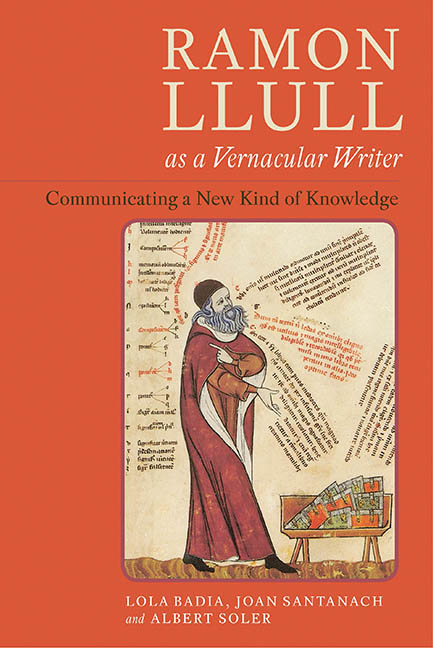Book contents
- Frontmatter
- Dedication
- Contents
- Illustrations
- Acknowledgements
- Abbreviations
- Introduction
- 1 Ramon Llull's Art, Language, and Literary Expression
- 2 Style and Genre in the Writings of Ramon Llull
- 3 The Composition and Dissemination of Ramon Llull's Texts, from Script to Print
- 4 Ramon Llull's Vernacular Context
- Epilogue. Ramon Llull's OEuvre as a Whole: Autobiographism and Self-Referentiality
- Appendix 1 First-Generation Llullian Manuscripts
- Appendix 2 Catalan Language and Literature in Relation to Ramon Llull
- Bibliography
- Index
1 - Ramon Llull's Art, Language, and Literary Expression
Published online by Cambridge University Press: 05 June 2016
- Frontmatter
- Dedication
- Contents
- Illustrations
- Acknowledgements
- Abbreviations
- Introduction
- 1 Ramon Llull's Art, Language, and Literary Expression
- 2 Style and Genre in the Writings of Ramon Llull
- 3 The Composition and Dissemination of Ramon Llull's Texts, from Script to Print
- 4 Ramon Llull's Vernacular Context
- Epilogue. Ramon Llull's OEuvre as a Whole: Autobiographism and Self-Referentiality
- Appendix 1 First-Generation Llullian Manuscripts
- Appendix 2 Catalan Language and Literature in Relation to Ramon Llull
- Bibliography
- Index
Summary
Ramon Llull's Art is capable of resolving any question and has applications pertaining to all branches of knowledge. On the basis of his Art, therefore, Llull justifies certain of the manifold and varied forms of expression he developed throughout the course of his lengthy career as a vernacular writer.
The monograph most worthy of note is the Rhetorica nova, a work that constitutes an entire programme, as indicated by its title. Llull, however, also situated language within the framework of the corporeal senses, expressed thoughts upon grammar, tried out in his own very personal way the various resources available to allegory, championed obscurity with didactic ends in mind, proposed a radical reform of homiletics and undertook self-commentary.
Llull did not work up a compact and continuous body of doctrine regarding language and communication, because reflection upon the specific functioning of such matters occupied a merely instrumental place in his apostolic and intellectual project: his practice as regards varied and effective forms of expression was much more urgent and necessary than was the theory relating thereto. For this reason there are formal aspects of his œuvre which exert a powerful, eye-catching effect upon the reader – aspects such as pseudoalgebraic expressions, recurrent elements, and self-commentary – none of which is either analysed or explained by Llull himself.
The aim of this chapter is to present the contributions Llull made to the theory of language and of literary expression. It will be necessary to do so both by reference to his own formulations, and by gathering information from an examination of his works.
From Algebraic Writing to a New Kind of Literature
A casual glance shows that the 260 plus works by Ramon Llull, written in Latin and Romance, display a great variety of forms. The Ars compendiosa inveniendi veritatem [Brief Art of Finding Truth], the first formulation of Llull's Art, was conceived as a presentation of the way in which the ‘Figures’ functioned within that Art. Llull inserted them into the body of the text, as can be seen from the page layout of the earliest manuscripts – in this particular case, in Latin. Passages of explanatory prose take a back seat and are filled with references to the letters which represent the concepts involved in the figures.
- Type
- Chapter
- Information
- Ramon Llull as a Vernacular WriterCommunicating a New Kind of Knowledge, pp. 37 - 90Publisher: Boydell & BrewerPrint publication year: 2016



